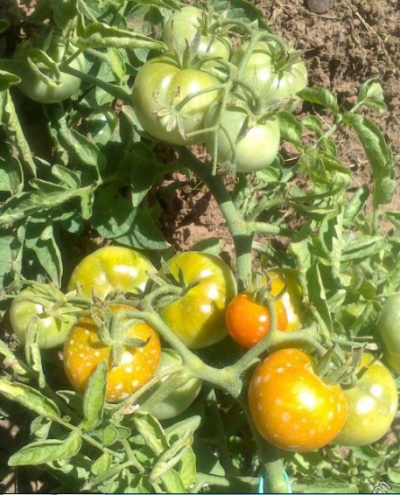
- Authors: Nastenko N.V., Kachainik V.G., Kandoba A.V. (Agrofirma Aelita LLC)
- Year of approval: 2008
- Category: grade
- Growth type: indeterminate
- Appointment: universal
- Ripening period: early
- Ripening time, days: 90-100
- Growing conditions: for open ground, for film greenhouses
- Transportability: good
- Bush size: tall
The Sakhalin tomato variety conquered many gardeners with its early maturity, decent harvest volume, and bright taste. But the main thing is at the same time its unpretentiousness and versatility.
Breeding history
An early ripe tomato variety was bred specifically for film greenhouses in the middle zone, as well as for open beds of southern subsidiary farms. The breeding work was carried out by such well-known specialists as N.V. Nastenko, V.G. Kachainik, A.V. Kandoba. The originator of the culture was Agrofirma Aelita LLC. In 2008, a culture called Sakhalin was included in the State Register of the Russian Federation. And since then, it can be found almost throughout the country.
Description of the variety
The plant has an indeterminate type of growth. The bushes of Sakhalin are tall, they are found in height from 1.6 to 1.8 meters, sometimes even higher. The leaves are rather large, colored green. Complex inflorescences, stalks have articulations.
The main qualities of the fruit
Sakhalin's fruits are round, smooth, and have an average density. Unripe tomatoes are light green, while fully ripe tomatoes are traditional red. The fruits themselves are small, their weight varies from 80 to 100 grams. Vegetables are distinguished by a decent keeping quality, they are well stored for almost two months after harvesting, and they are well transported.
Taste characteristics
Many who have tried Sakhalin tomatoes note their excellent, sweet taste. The pulp of lettuce tomatoes is very juicy. In addition to fresh consumption, as ingredients for salad, they are ideal for various types of processing and canning with whole fruits.
Ripening and fruiting
Sakhalin is an early ripening variety. Only 90-100 days pass between shoots and the beginning of fruit ripening. The tomato culture is distinguished by abundant, as well as long-term fruiting.
Yield
Sakhalin is considered a high-yielding variety, since, on average, 3.7 kilograms of marketable tomatoes can be obtained from one square meter.
The timing of planting seedlings and planting in the ground
Sakhalin tomato seeds are sown in March, from the 1st to the 15th. Seedlings are subject to mandatory picking when 1-2 green leaves appear. The grown sprouts are planted in the ground after 60-65 days, that is, from May 15 to June 5, respectively.

Growing tomato seedlings is an extremely important process, because it largely depends on whether the gardener will be able to harvest at all. All aspects must be taken into account, from seedbed preparation to planting in the ground.
Landing scheme
It is better to place varietal tomatoes per 1 m2 in an amount of no more than 3-4 plants. The optimal planting pattern is 50x40 cm.

Growing and care
The Sakhalin tomato, due to its tall stature, needs a garter and the formation of bushes. Stepsons (lateral shoots) are removed regularly, up to 1 brush. Sakhalin bushes are grown in 1-2 stems. The growth point is pinched after 8-9 inflorescences. And also after ripening of the fruits, all lower leaves are removed for 2 brushes. The culture in question requires simple and uncomplicated care, including, in addition to pinching and garter, regular watering, as well as weeding, loosening and feeding.




A plant needs different micronutrients at each stage of growth. All fertilizers can be divided into two groups: mineral and organic. Folk remedies are often used: iodine, yeast, bird droppings, eggshells.
It is important to observe the rate and period of feeding. This also applies to folk remedies and organic fertilizers.
Disease and pest resistance
The variety is distinguished by strong immunity, as well as resistance to many ailments of nightshade crops. It is especially high in relation to such diseases as verticillosis, fusarium wilting, tobacco mosaic virus (TMV).


Growing regions
The Sakhalin tomato variety is zoned practically throughout the country. It is already successfully grown in private subsidiary farms in the northern, Northwestern, Central, Volga-Vyatka regions. And also good harvests are possible in the Central Black Earth Region, in the North Caucasus, the Middle and Lower Volga, the Urals, Siberia and the Far East.

























































































